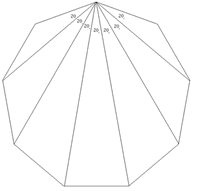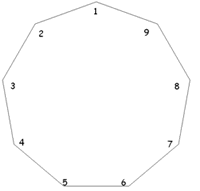Pegboard quads
Make different quadrilaterals on a nine-point pegboard, and work out their angles. What do you notice?
Problem
An updated vesion of this problem appears at Cyclic Quadrilaterals
Image
Make five different quadrilaterals on a nine-point pegboard, without using the centre peg.
Work out the angles in each quadrilateral you make.
Perhaps checking that the four angles do add up to $360^\circ$!
Now, what other relationships can you see?
For printable sets of circle templates for use with this activity, please see Printable Resources page.
Many thanks to Geoff Faux who introduced us to the merits of the 9 pin circular geo-board.
Getting Started
If you need hints for this, look at the three problems in Stage Three this month. This problem builds on that.
Student Solutions
This solution was submitted by Michael of St John Payne school. Does anyone have any other ideas?
Image

Image

If we draw lines from a particular vertex to every other, then the angle separating $2$ adjacent vertices is $20^\circ$ (Can you explain this? -- Ed.) . If we label the polygon as shown in the right hand diagram, the angle $416$ is going to be two lots of $20^\circ$ and therefore $40^\circ$. This means that we have a general rule:
Angle $ABC = 20 \times (|A-C|)$ when A > C and A > B or A < C and A < B . But this will only work for angles where $B$ isn't between $A$ and $C$. For angles where $B$ is between $A$ and $C$ we need to go the long way round the polygon from $A$ to $C$, or in other words the whole polygon take away $A$ to $C$. So we can come up with the rule: Angle $ABC = 20 \times ( 9 - |A-C| )$ for any angle where A < B < C or A > B > C .
E.g. Angle $124 = 20 \times (9 |1-4| ) = 20 \times 6 = 120$
We can use these rules to show that the angles in any quadrilateral $ABCD$ on the pegboard must add up to $360^\circ$. If you rotate the peg board so that $A$ is always at point $1$ then $ABC$ and $BCD$ will obey the second rule and $CDA$ and $DAB$ will obey the first rule. Therefore \begin{eqnarray} ABC + BCD + CDA + BAC &=& 20 \times (9-|A-C|)+20 \times (9-|B-D|)+20 \times (|C-A|)+20 \times (|D-B|)\\ &=&360. \end{eqnarray} We can also deduce that $2$ opposite of the quadrilateral angles will add up to $180^\circ$: For quadrilateral $ABCD$, where the pegboard is rotated so that point $A$ is on peg $1$, Angle $ABC$ will obey the first rule and Angle $CDA$ will obey the second rule. Therefore
\begin{eqnarray} 20 \times ( 9 - |A-C|) + 20 \times (|A-C|) &=& \mbox{ sum of to opposite angles} \\ & = &20 \times (9 - |A-C| + |A-C| ) \\ &=& 20 \times 9 = 180^\circ \end{eqnarray}
Teachers' Resources
An article by Paul Andrews Angle Measurement: An Opportunity for Equity, provides the best notes for background to this problem.
